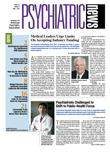Though the data are limited, there is adequate evidence to support the strategy of screening and treating adolescents for depression, reported the U.S. Preventive Services Task Force (USPSTF) in the April Pediatrics.
Evidence remains insufficient, however, to judge the value of screening children aged 7 to 11, said the group, a panel of independent experts in prevention and primary care appointed by the federal Agency for Healthcare Research and Quality.
“This is the first time that the American Academy of Pediatrics has endorsed screening adolescents for depression,” said Michael Houston, M.D., chair of APA's Council on Children, Adolescents, and Their Families, and an associate clinical professor of psychiatry at George Washington University.“ It will have an effect on clinical practice, although changes like this take a while to work their way into the profession.”
The recommendations come despite an absence of studies directly examining the health outcomes of screening children and adolescents for depression, wrote the authors. “Therefore, we cannot say whether the use of systematic screening improves identification, treatment, and outcomes of depression over standard identification methods.”
The recommendations come with one other large caveat. Screening should be used “when systems are in place to ensure accurate diagnosis, psychotherapy (cognitive-behavioral or interpersonal), and follow-up.”
“Ideally, we would have both screening and the availability of treatment, so the recommendation underlines the importance of putting these services into place and also highlights the workforce issues in children's mental health,” said Houston, who was not associated with the USPSTF review.
The recommendations drew on new research to change the USPSTF's 2002 report, which concluded that evidence was insufficient to determine the value of routine screening for children or adolescents for major depression.
The USPSTF report authors also pointed to gaps in existing research, finding no trials that are looking at the health outcomes of programs that screen young people for depression or assessing whether screening resulted in more children or adolescents being identified or treated for depression. No studies evaluated any harms related to such depression screening.
Task force reviewers also found that the studies of screening tests had methodological flaws. “Limited” evidence, from “fair-quality studies,” found that sensitivity of screening tests varied from 18 percent to 100 percent, while specificity ranged from 38 percent to 97 percent. These differences, they said, “make generalizations difficult.”
Despite the lack of evidence for screening preteenagers, some psychiatrists would prefer to see greater awareness of risk factors for depression before age 12, but not by relying only on findings from screening tests.
“Screening in teenagers seems late to me,” said John Walkup, M.D., an associate professor of psychiatry at Johns Hopkins University.“ Pediatricians should be doing more earlier, by asking about family history of depression, parenting practices, and other family factors.”
If, for instance, parents have serious depression, pediatricians can ask how well they are keeping it under control, suggested Walkup. Symptoms of depression in children can alert the family, the child, and the doctor to be ready to deal with it so it doesn't come as a complete shock in the teen years. The parents can look for resources to help them cope when under less pressure, so referral can be tied in with pediatric care.
Houston raised another question not addressed in the recommendations: where should adolescents be screened for depression—in the clinic or their school?
“Teenagers enter the prime years of risk just as they are less and less likely to be seen by pediatricians,” Houston said.
Once screened, and depression detected, however, adolescents benefit from treatment with medication or psychotherapy or both, although there is some risk of suicidal ideation among those using the medications, said the USPSTF.
“In total, even the most conservative estimates indicate that the risk of suicidality may increase absolutely by 1 to 2 percent,” wrote the authors. “No suicide deaths occurred in any of the trials [reviewed].”
The evidence review for the recommendations was prepared by Selvi Williams, M.D., M.P.H., and colleagues of the Center for Health Research at Kaiser Permanente and by the Oregon Evidence-Based Practice Center, both in Portland. Funding was provided by the Agency for Healthcare Research and Quality.
Other documents on the USPSTF's recommendations are posted at<www.ahrq.gov/clinic/uspstf/uspschdepr.htm>.▪
